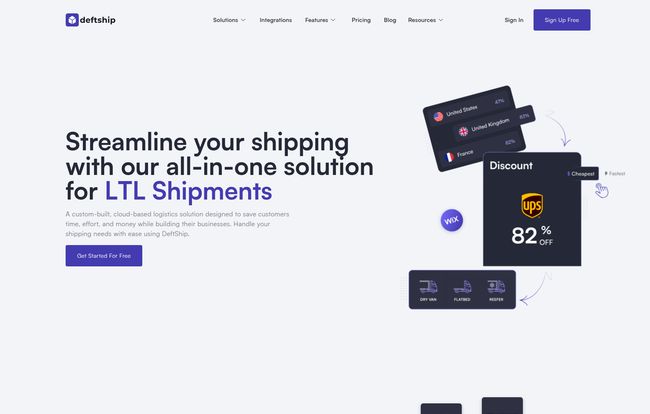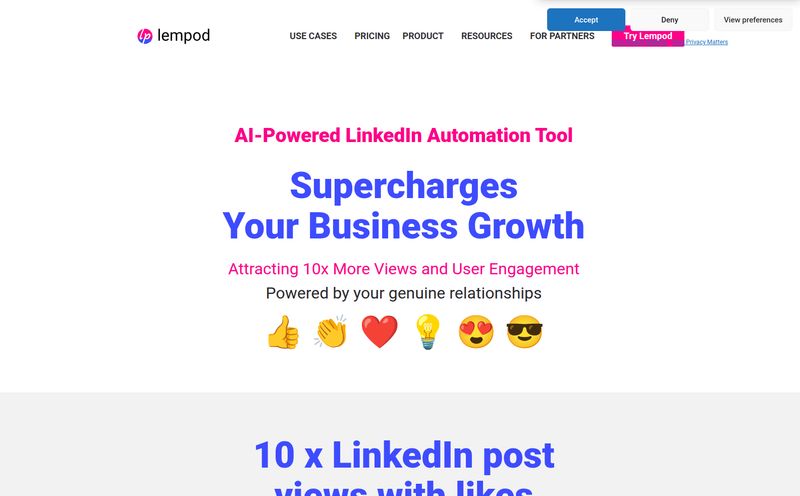If you run an ecommerce store, you know the feeling. That sinking sensation when you have 50 orders to get out the door, and you're staring at a dozen browser tabs: one for USPS, one for FedEx, another for UPS, maybe even one for DHL if you're feeling spicy. You're copy-pasting addresses, comparing rates, and praying you don't mix up a label. It's a soul-sucking, time-consuming vortex that I wouldn't wish on my worst competitor. Okay, maybe I would.
For years, I've seen clients struggle with this. They either burn hours they don't have or shell out hefty monthly fees for software that promises to solve it all. So when a platform like DeftShip pops up on my radar screaming "Free Forever," my professional skepticism kicks in. Is it really free? Or is it “free” like the weird-smelling cheese samples at the grocery store—a tiny taste to lure you into a much bigger commitment? Let's take a look.
What Exactly is DeftShip Supposed to Do?
On the surface, DeftShip presents itself as a mission control for your packages. It’s a cloud-based, multi-carrier shipping platform. In plain English, that means it's one central place where you can manage all your shipments from different carriers. The whole idea is to pull all your orders from your online store (like Shopify or WooCommerce), let you compare shipping rates from over 50 carriers in a single click, and print the cheapest or fastest label. Simple, right?
The promise is huge: save time, slash your shipping costs, and automate the entire headache-inducing process. It's the dream. But as we know in the world of SaaS, the devil is always in the details.
The Big Question: DeftShip's Pricing Model
This is where my investigation started. The homepage is loud and clear: "Deftship is free to use." No hidden fees, no monthly subscriptions, no credit card required. It sounds too good to be true. And it kinda is, but not in a bad way.
When you dig into their pricing page, you see the phrase "Free Forever." Awesome. But right below it, there's a little asterisk in spirit, if not in text: "You have access to all great features and you only pay ¢45/Label with your own connected carrier accounts."

Visit DeftShip
Aha! There it is. So, let's break this down. It seems DeftShip operates on a model similar to other players in the space, like Shippo. You can likely use DeftShip's pre-negotiated, discounted rates with carriers like USPS and DHL for free. You just pay the cost of the postage. However, if you're a bigger business and you have your own negotiated rates with, say, FedEx (because you ship a ton of heavy stuff), you can connect your own account. When you use your own account to generate a label, DeftShip charges you a small 45-cent fee.
Honestly? That's more than fair. It's incredibly transparent once you find it, and 45 cents is a tiny price to pay for the automation and centralization they offer. This isn't a bait-and-switch; it's just a business model that could be explained a little more clearly on the homepage. For a startup or small business, this is a fantastic deal.
A Look at The Core Features
So, what do you get for your... well, for your nothing-down-and-maybe-45-cents? The feature set looks pretty robust on paper.
True Multi-Carrier Magic
Supporting over 50 carriers is no small feat. This includes the big guys—UPS, USPS, FedEx, DHL—but also regional carriers and freight options. The real power here isn't just the number of logos on their site; it's the integrated rate comparison. Seeing all your options on one screen without having to re-enter package details is, and I don't say this lightly, a game-changer. It turns a 10-minute task into a 10-second one.
The Power of Shipping Automation
This is where I get really excited. DeftShip has an "If-Then" automation engine. This is the stuff that separates the amateurs from the pros. You can create rules that automatically manage your shipping decisions. For instance:
- IF an order's package weight is under 1 pound, THEN set the shipping service to USPS First-Class Mail.
- IF the customer's address is in California, THEN assign it to the West Coast warehouse.
- IF the order value is over $100, THEN automatically add shipping insurance.
Setting this up might take an hour, but it will save you hundreds of hours down the line. This is how you scale an operations team of one into something that feels much, much bigger.
Seamless Ecommerce Integrations
A shipping platform is useless if it doesn't talk to your store. DeftShip seems to get this, offering integrations with the platforms that matter: Shopify, WooCommerce, eBay, Ecwid, BigCommerce, and more. This means your orders flow directly into the system. No more manually exporting CSV files or, heaven forbid, copy-pasting addresses. I once sent a $500 order to the wrong state because of a copy-paste error in my early days. Never again. This integration is your safety net.
What About that API?
For the non-tech crowd, an API is basically a way for different software to talk to each other. DeftShip offering API access is a big deal. It means that if you have a custom-built ecomerce platform or a unique internal workflow, your developers can plug DeftShip's logic directly into your system. It's a clear signal that they're not just thinking about the small Shopify store; they're building for scale.
The Good, The Bad, and The Vague
No tool is perfect. After poking around, here's my honest breakdown.
The Good Stuff is pretty obvious. The price—or lack thereof—is a massive draw. For a new business watching every penny, getting access to this level of automation and rate shopping for free is just incredible. The feature set, particularly the automation rules and broad integrations, is competitive with paid platforms that charge $30, $50, or even more per month.
Where I raise an eyebrow, though, is in the details. The website is a bit… vague. For example, it touts amazing discounted rates through its partners but doesn't give many concrete examples of what those discounts are. Are we talking 15% off retail? 40%? This lack of specifics can make it hard to calculate the actual savings without signing up and running a few test labels.
Also, the reliance on these partner carriers for the truly free experience means you're tied to their negotiated terms. For 90% of users, this is probably a better deal than they could get on their own. But for some high-volume shippers, their own negotiated rates might be better, which kicks them into that ¢45/label plan. It's not a dealbreaker, just something to be aware of.
Who is DeftShip Really For?
Based on what I've seen, I can picture the ideal DeftShip user pretty clearly.
- The Startup and Solopreneur: This is a no-brainer. If you're shipping your first 500 orders, there is almost no reason to pay a monthly fee for another service when DeftShip exists. It gives you the tools of a much larger operation from day one.
- The Growing Ecommerce Store: If you're doing a few hundred to a few thousand orders a month and feeling the pain of your current process (or your current software's monthly bill), DeftShip is a compelling alternative. The automation alone is worth the switch.
- The Enterprise-Level Giant: This is a maybe. The API is promising, but large companies will need to do their due diligence on uptime, customer support response times, and the ability to handle massive volume spikes. DeftShip is on the right track, but big corps move slowly and cautiously.
My Final Verdict on DeftShip
So, is DeftShip the real deal? Yeah, I think so. It's a powerful, feature-rich shipping platform that has cleverly eliminated the single biggest barrier to entry: the monthly subscription fee.
The “free” claim is mostly legitimate, with the 45-cent fee for using your own carrier accounts being a perfectly reasonable and very competitive charge. The vagueness on the site is a minor gripe, one that I suspect will be ironed out as the company matures.
My advice? Give it a try. The risk is non-existent. You can sign up, connect your store, and compare their rates on your next few orders without paying a dime. If it saves you money, great. If it saves you time, even better. If it does both, you’ve just found your new best friend in the war against logistical headaches.
Frequently Asked Questions about DeftShip
Is DeftShip really 100% free?
It's free to use the platform and to generate labels using DeftShip's discounted carrier rates. You only pay the actual postage cost. If you want to connect your own carrier accounts (e.g., your personal FedEx account with its own negotiated rates), there is a ¢45 fee per label generated.
What e-commerce platforms does DeftShip integrate with?
DeftShip integrates with many major e-commerce platforms, including Shopify, WooCommerce, eBay, Ecwid, and BigCommerce, allowing for automatic order syncing.
Can I use my own negotiated shipping rates with DeftShip?
Yes, you can. This is a key feature. Connecting your own carrier accounts allows you to use your pre-negotiated rates, though it does incur the small ¢45 fee per label.
How many carriers does DeftShip support?
DeftShip supports over 50 global carriers, including major players like USPS, UPS, FedEx, and DHL, as well as various regional and freight carriers.
Is DeftShip good for international shipping?
Yes, with support for carriers like DHL and others that specialize in international logistics, DeftShip is equipped to handle global shipping, including rate comparison for international services.
Is there a mobile app for DeftShip?
Yes, the website shows QR codes to download the DeftShip app, allowing you to create and manage shipments from anywhere, anytime.
Shipping will always be a complex part of running an online business, but it doesn't have to be a nightmare. Tools like DeftShip are chipping away at the complexity, one automated label at a time. And when they do it for a price that any business can afford, it's definitely worth paying attention to.



